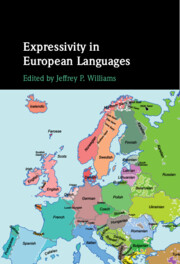Book contents
10 - Vindicating the role of ideophones as a typological feature of Basque
from Vasconian
Published online by Cambridge University Press: 24 August 2023
Summary
Basque possesses a large, distinctive class of iconic elements known as ideophones (onomatopoeia in traditional terms). This chapter succinctly describes the main typological characteristics of these words, and argues that, due to their prominent status in Basque and in linguistic typology in general, they should be considered one of the main typological traits of Basque, alongside other linguistic features specific to this language such as ergativity, case alignment, and double marking.
- Type
- Chapter
- Information
- Expressivity in European Languages , pp. 313 - 334Publisher: Cambridge University PressPrint publication year: 2023

